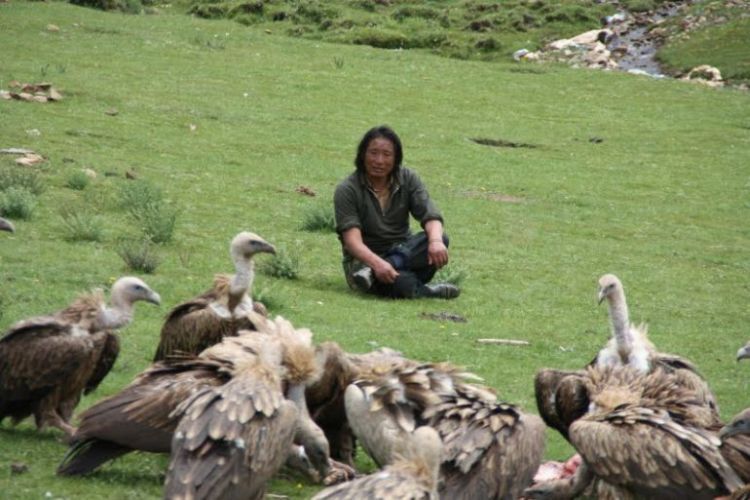
photo credit: www.elephantjournal.com
In a Tibetan Buddhist burial ritual, it is believed that the physical body is just an empty vessel after death, which is then followed by rebirth. For Tibetan Buddhists, heaven is believed to be a place where soul or spirit await reincarnation.
Though it is thought to have evolved out of economical and practical reasons, the jhator funeral ritual is considered to be a path to rebirth. In this sense, Jhator reflects the often universal belief that death is not the end.
The region in which jhator is common practice must be above the tree line, where the ground is rocky. In this landscape, it is nearly impossible to dig graves. Moreover, fuel and timber are scarce, making the Tibetan religious practice more practical than an underground burial, or cremation.
Jhator, which means “giving alms to the birds,” is also known as a sky burial. The ancient burial ritual consists of defleshing and chopping the bones of the corpse and feeding them to vultures.
It is believed that the vultures are Dakinis. Dakini means “sky dancer”– and is the Tibetan equivalent of angels. The Dakinis are thought to take the soul or spirit of the deceased into heaven, flying into the sky after eating the flesh and bones. This heaven is understood to be a windy place where souls await reincarnation.
After death occurs, the deceased is left untouched for three days. Monks chant around the corpse before the sky burial, while the corpse is cleaned and wrapped in white cloth. Consequentially, it is not a suitable ceremony for children, pregnant women, or those who are very susceptible to infectious diseases.
“The Dakinis are thought to take the soul or spirit of the deceased into heaven, flying into the sky after eating the flesh and bones.”
The origin of the Buddhist sky burial remains hidden in Tibetan history. Though the ritual may seem repulsive to the Western eye, it is a pivotal practice that carries fascinating Tibetan religious tradition into the contemporary world. The “human flesh donation,” as it is thought of, is considered virtuous because it saves the lives of small animals that the vultures might otherwise capture for food.
Tibetans are encouraged to witness the ancient ritual. In this way, they can face death openly and feel the impermanence of life. The Tibetan ritual is a way to learn an essential part of the Buddhist philosophy: that one should foster a sense of detachment. This detatchment allows Buddhists to separate the earthly and spiritual worlds — all while creating a connection between the two in a way that is unique to their culture.
Other types of burial rituals include stupa burial, which is reserved for high lamas and other dignitaries. Contrastingly, water burials were traditionally reserved for those of a lesser economic status.
The practice of jhator shows us that despite economic, political, or social differences, all human beings care about the process of the soul or spirit reaching its destiny. The question of “what’s next?” proves universal; whether it’s heaven — temporarily, while awaiting reincarnation or rebirth — the slightly similar, yet different idea of next world, or the Christian idea of eternal life, all share commonality in the belief death is not the end.
Related articles:

 Tibetan Buddhist Burial Ritual
Tibetan Buddhist Burial Ritual


 “The Boy and the Heron” by Hayao Miyazaki
“The Boy and the Heron” by Hayao Miyazaki
 Honoring Seniors, Caregivers: Inside the Vision of Carehaus
Honoring Seniors, Caregivers: Inside the Vision of Carehaus
 “In Case You Don’t Live Forever” by Ben Platt
“In Case You Don’t Live Forever” by Ben Platt















i am a dead person by a dakini…i have come into a new world…please tell me how can i get my young soul again and how can i go into physical world again..i am helpless…please help me.
Report this comment